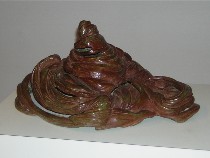 We needed to change our routine. That’s our explanation for eschewing the art in Old City for First Friday even though that’s the FF focus and the locus.
We needed to change our routine. That’s our explanation for eschewing the art in Old City for First Friday even though that’s the FF focus and the locus.
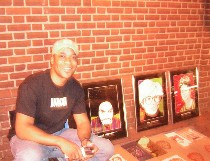 Speaking of the focus and the locus, we did walk down Old City streets on our way to see Buster Simpson’s King George at Temple Gallery (see Roberta’s previous post), and on our way we passed by an energetic scene of people hawking their art, including Rah Crawford (right), who has a show coming up in November at Cubix Gallery in Old City. He was giving people a preview of what his work is like, he said.
Speaking of the focus and the locus, we did walk down Old City streets on our way to see Buster Simpson’s King George at Temple Gallery (see Roberta’s previous post), and on our way we passed by an energetic scene of people hawking their art, including Rah Crawford (right), who has a show coming up in November at Cubix Gallery in Old City. He was giving people a preview of what his work is like, he said.
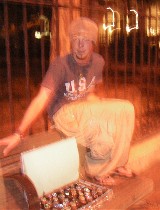 We passed some musicians on a corner, and a young fellow named Collin Darrell (left, and blurry, but you get the picture) was displaying some terrific looking glass lampwork pendants and belt buckles. He took a class, he said, at Philadelphia Glass Works (see post) and then went off on his own.
We passed some musicians on a corner, and a young fellow named Collin Darrell (left, and blurry, but you get the picture) was displaying some terrific looking glass lampwork pendants and belt buckles. He took a class, he said, at Philadelphia Glass Works (see post) and then went off on his own.
 Some nice young women, Mary E. Wehrung (right) and Mary L. Marino, from New Paltz (N.Y.) University, were selling ceramics. Wehrung’s carved platters were particularly noteworthy–I would have bought one but for the burden of carrying it while holding a water bottle, taking notes and taking photographs at the same time.
Some nice young women, Mary E. Wehrung (right) and Mary L. Marino, from New Paltz (N.Y.) University, were selling ceramics. Wehrung’s carved platters were particularly noteworthy–I would have bought one but for the burden of carrying it while holding a water bottle, taking notes and taking photographs at the same time.
 Another young man was selling small landscapes–the very opposite of normal street fare. He ran out of cards with his name, and I’m a bear of very little brain, so I can’t remember who he is. [Editor’s note 10/4/04: Fortunately, Roberta was able to remember that we had a whole conversation about his name, which is Steve Martin, just like the comedian.] And Suzanne Francis, who we often see on the streets of Old City, was doing a brisk business with her portraits of houses and of dogs.
Another young man was selling small landscapes–the very opposite of normal street fare. He ran out of cards with his name, and I’m a bear of very little brain, so I can’t remember who he is. [Editor’s note 10/4/04: Fortunately, Roberta was able to remember that we had a whole conversation about his name, which is Steve Martin, just like the comedian.] And Suzanne Francis, who we often see on the streets of Old City, was doing a brisk business with her portraits of houses and of dogs.
But to break our routine, we first went south of Market and then we went north of Girard to Northern Liberties’ MBN Gallery and Ashley Gallery, by which time we were faint with hunger and exhaustion. But it was worth it–some new vistas and new art–lots of it sculpture for a change.
In the world of sculpture, Locks was the big kahuna as far as big names go. Lynda Benglis and Isaac Witkin hardly need attention from artblog, since they’ll get reviews aplenty in more mainstream media, but I can’t help myself, because they both had voluptuous metalwork that I’d never seen from either of them before.
 Benglis, known for her acts of feminist outrage and outrageousness when she was young, had a couple of cast bronze fountains (right, “Summer Dreams”) of such baroque drippiness and blobbiness that I hardly know how to describe them. They were female, for one thing, and they were tongue-in-cheek cheesy and kitschy–as in the bad taste of too much gold jewelry and makeup, trying to look young and not succeeding, but still coming across as a sexy piece of work.
Benglis, known for her acts of feminist outrage and outrageousness when she was young, had a couple of cast bronze fountains (right, “Summer Dreams”) of such baroque drippiness and blobbiness that I hardly know how to describe them. They were female, for one thing, and they were tongue-in-cheek cheesy and kitschy–as in the bad taste of too much gold jewelry and makeup, trying to look young and not succeeding, but still coming across as a sexy piece of work.
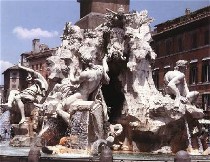 She out-Bernini-ed Bernini, and made baroque look tired (left, Bernini’s “Fountain of the Four Rivers” in Rome).
She out-Bernini-ed Bernini, and made baroque look tired (left, Bernini’s “Fountain of the Four Rivers” in Rome).
(For Roberta’s terrific 2002 artnet.com interview of Benglis, go here.)
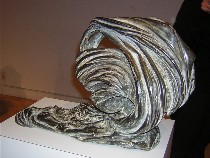 And Witkin, whose work has often seemed bogged down in a go-nowhere technique, had some wonderful fluid twists and turns of metal full of a sexiness, slump and drape that I don’t normally associate with his work. These pieces’ silky curves require some hands-on viewing (I sneaked a feel or two when no one was looking), and this one here, “Wave,” (image right) brought to mind Hokusai’s classic wave (image left below; image at top of post is Witkin’s “Eruption”).
And Witkin, whose work has often seemed bogged down in a go-nowhere technique, had some wonderful fluid twists and turns of metal full of a sexiness, slump and drape that I don’t normally associate with his work. These pieces’ silky curves require some hands-on viewing (I sneaked a feel or two when no one was looking), and this one here, “Wave,” (image right) brought to mind Hokusai’s classic wave (image left below; image at top of post is Witkin’s “Eruption”).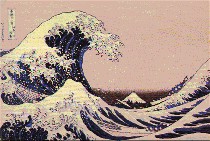 In Northern Liberties we started at MBN Studios, and I’d have to say this was the most interesting stop of the evening for me. First of all, the space is a trip. The old industrial or loft space includes a set up for a DJ and some sofas and a dance floor. Alas, no music was going on when we were there, but they’re set up to party.
In Northern Liberties we started at MBN Studios, and I’d have to say this was the most interesting stop of the evening for me. First of all, the space is a trip. The old industrial or loft space includes a set up for a DJ and some sofas and a dance floor. Alas, no music was going on when we were there, but they’re set up to party.
The featured exhibition, “Horse Power,” was work by four artists–Juice, Rob-O, Pose II and Caroll T. What I found interesting here was the subject matter.
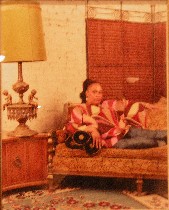 Roberta and I again divied up what we saw, so I’ll just report on photographer Caroll T (aka Caroll Taveras) and Pose II (Daniel Hopkins).
Roberta and I again divied up what we saw, so I’ll just report on photographer Caroll T (aka Caroll Taveras) and Pose II (Daniel Hopkins).
Caroll T, a native of the Dominican Republic, moved to Berlin after college, where she worked with photographer Tomas Adel and performed with the Platipus theater group. She spent the past two years in Amsterdam and has sold photographs to magazines like Dutch Elle, Vibe and people.
Caroll T’s photo portraits displayed in this show stand out for their window into a set of cultural expectations in the rendering of an image. The work reminds me of Rembrandt and Velasquez for the inclusion in the portraits symbols of the lives the subjects live–and therefore the things in which the subjects find value. This is the antithesis of portraiture taken in a photography studio with a standard backdrop, so that all you get is the physiognomy.
“Miss Lady Alma,” reclining on her divan a la Mme. Recamier, surrounded by richly decorative materials and household goods, is projecting a confident sexiness that his nothing to do with porno’s objectification of women. It’s a sexiness that’s not usually projected in the white art world mainstream, a product of the same subculture that I used to encounter when I called some of my African-American women students back when I taught in the Journalism Department at Temple University. The phone machine message would include a swell of music and a sexy, kittenish voice–a projection your average white daughter would be embarrassed about should her mother dial up and get the message.
 “Rich Medina and Fela” includes not just Fela, the dog, but also Medina’s LP collection and his guitar. You know a lot about him from this. The order of the collection bespeaks an orderly scholarliness, a seriousness of purpose. The dog suggests that there’s no other family.
“Rich Medina and Fela” includes not just Fela, the dog, but also Medina’s LP collection and his guitar. You know a lot about him from this. The order of the collection bespeaks an orderly scholarliness, a seriousness of purpose. The dog suggests that there’s no other family.
The beautiful portrait “King Britt” includes an artwork and an exotic-looking musical instrument. The two Pocahantas images show Miss Pocahantas with her deer skin dress and her house decorated with Indian artifacts as well as artifacts of her life. She projects a pride in the somewhat fantastic self-invention that embroiders what I presume to be a Native American background mixed in with African roots.
 Also at MBN, Pose II, a former tagger who is part of the Philadelphia Mural Arts Program had a couple of paintings that caught my eye. Painted on found long, vertical panels with a nice oily-looking finish,”Soul of a Pimp” and “Robin” both pulled me back for a second long look. (“Soul of a Pimp” right; sorry about the reflections from the lights in all the MBN photos.)
Also at MBN, Pose II, a former tagger who is part of the Philadelphia Mural Arts Program had a couple of paintings that caught my eye. Painted on found long, vertical panels with a nice oily-looking finish,”Soul of a Pimp” and “Robin” both pulled me back for a second long look. (“Soul of a Pimp” right; sorry about the reflections from the lights in all the MBN photos.)
The pimp is just a skinny kid, with his enormous, fur-trimmed coat a kind of house covered with room/pockets, no doubt for storing his stable of girls. The curled lip sneer is comic, the almost cartoony presence a reminder of Lisa Yuscavage’s distorted women. The feather in the pimp’s hat is echoed in a couple of brush-stroke gestures that enliven the otherwise black, oily background. I think Pose II must be looking at Rembrandt, judging by the darkness of the backgrounds.
 Robin has her hair bound up in one of those towering African cloths a la Erykah Badu, her dreads tumbling out the top, one very unruly one falling down like a lightening bolt for the length of the tower on top of her head (“Robin,” left).
Robin has her hair bound up in one of those towering African cloths a la Erykah Badu, her dreads tumbling out the top, one very unruly one falling down like a lightening bolt for the length of the tower on top of her head (“Robin,” left).
No white people are making these kinds of images, and it’s a sore lack in the art world, which needs to get out of its hermetic capsule and give kudos to the African-American work that’s interesting.
Others showing at MBN were Paul Hamanaka (an installation) and Denis Daly (painting). Hamanaka was charming when we met him, explaining that the styrofoam balls receeding into the distance were the climb from Hell to Heaven. I’m not sure how serious he was about this explanation, because we all were busy laughing.
 At Ashley Gallery, we looked at work by Edward A. Raffel (the show is about to come down Oct. 5, alas), who makes objects from a surprising array of industrial and homey materials–like o-rings, roof flashing and plastic champagne cups. Not all the pieces worked equally well.
At Ashley Gallery, we looked at work by Edward A. Raffel (the show is about to come down Oct. 5, alas), who makes objects from a surprising array of industrial and homey materials–like o-rings, roof flashing and plastic champagne cups. Not all the pieces worked equally well.
For instance the crosses obsessively covered with thousands of picture hooks seemed heavy-handed. If gallerist Diane Ashley hadn’t explained the Raffel was anti-religious, I don’t know that I would have figured it out from the crosses, which are oppressive enough to be interpreted either way.
But the little green mirror box with pearlescent champagne cups was charming, a play on what’s valuable and what’s useful and decoration. I loved the objects that reminded me of my grandmother’s grater and I thought the giant blackcube “Self” (downstairs at the cafe next door because, Ashley explained, she couldn’t fit it through her door) was a load of fun. The box has a mirrored interior that allows you to see yourself reflected unto infinity as the cube spins around, an experience that at this point in my life is less than appealing.
 Raffel is big on mirrors, big on lights, and big on motors in his sculptures. The self-taught artist, who hails from Cleveland, has the obsessive, gizmo, found-object appeal going. He also has some wonderful paintings (not on display) that Ashley pulled out for us. I loved the ones that felt like a mix of Mona Lisa meets Jim Nutt.
Raffel is big on mirrors, big on lights, and big on motors in his sculptures. The self-taught artist, who hails from Cleveland, has the obsessive, gizmo, found-object appeal going. He also has some wonderful paintings (not on display) that Ashley pulled out for us. I loved the ones that felt like a mix of Mona Lisa meets Jim Nutt.
Ashley, by the way, who used to have a New York Gallery and then a gallery in Maryland, had the unfortunate timing of opening in Philadelphia shortly before 9/11. The gallery nearly went under. Fortunately Ashley, who is a bundle of energy, survived. She has an interesting mix of artists, so don’t count her out of your gallery tours. Coming up Oct. 9 to 31, she has a show by painter Phil Blank and musician Ben Hartlage, “Frozen Songs: a Collaboration.”









